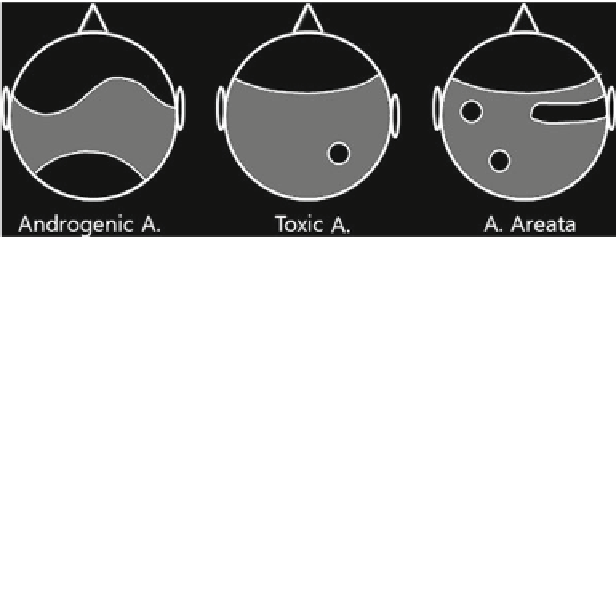Biology Reference
In-Depth Information
Fig. 25.1
Top-down view of different alopecias. Alopecia (A.) varies in shape and pattern of
development. Androgenic A. and A. areata are affected mostly by individual genetic backgrounds.
The areas of hair loss, caused by androgenic A. and A. areata, expand with age. Toxic A. is affected
by environmental stresses and can be cured with relevant treatments
Table 25.1
Alopecia statistics
Sex
Characterization
(%)
Male
-Androgenic in all baldness
95
-Showing signs of balding by 50s
67
-With male pattern baldness by 50s
50
-Balding by 30s
25
Female
-Suffering hair loss by 50s
25
root. Recently, astressin-B has been approved as anti-alopecia medicine by the FDA
of the United States as a nonselective antagonist to corticotropin-releasing hormone.
It prompted copious hair growth in mice which was subjected to an alopecia treat-
ment (Wang et al.
2011
). Finasteride is used to treat alopecia especially in the form
of male pattern baldness as well as benign prostatic hyperplasia. Finasteride inhibits
the conversion of testosterone to dihydrotestosterone (Evers et al.
2010
) .
Hair growth and regeneration test model is available in vitro and in vivo. Mice
are frequently used as model systems in evaluating anti-alopecia candidate agents
(Porter
2003
). This study, however, utilizes
Caenorhabditis elegans
as the model
system considering they correctly represent cellular stress leading to ER stress at the
individual level (Link et al.
2001
; Silverman et al.
2009
) . Under treatment of candi-
date agents including taurine, their response to the ER stress will be very compre-
hensive and less laborious. In this study, the two commercially available anti-alopecia
agents were evaluated in terms of ER stress level along with taurine: The extent of
anti-ER stress effect was evaluated according to their effect on the stress protein
expression and, functionally, on the basis of life length, mobility, and offspring
numbers which constitute very useful indicators for physiological stress (Estes et al.
2005
; Ayyadevara et al.
2007
; Boyd et al.
2007
; Davies and Hart
2008
) .








Search WWH ::

Custom Search